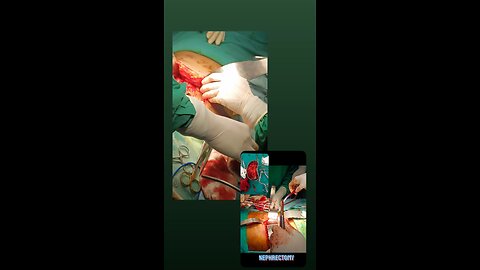
-
nephrectomy surgery
 pradeeppippal97nephrectomy is a surgical procedure to remove all or part of a kidney. It's typically performed to treat kidney cancer or remove a diseased kidney, but it can also be done to remove a healthy kidney for transplant. There are two main types: partial nephrectomy (removing part of the kidney) and radical nephrectomy (removing the entire kidney). Types of Nephrectomy: Partial Nephrectomy: Also known as "kidney-sparing" surgery, this procedure removes only the diseased or damaged portion of the kidney, leaving the healthy tissue intact. Radical Nephrectomy: This surgery involves removing the entire kidney, along with the surrounding fat and adrenal gland (in some cases), and sometimes nearby lymph nodes. Nephroureterectomy: This procedure removes the kidney and the ureter (the tube that carries urine from the kidney to the bladder), sometimes with a portion of the bladder. Reasons for Nephrectomy: Kidney Cancer: Nephrectomy is a common treatment for both cancerous and non-cancerous kidney tumors. Other Kidney Diseases: Infections, injuries, and birth defects can necessitate nephrectomy. Kidney Donation: A healthy kidney can be removed from a living or deceased donor for transplantation. Palliative Care: In some cases, a nephrectomy can be performed to relieve pain or other symptoms associated with advanced kidney cancer. Surgical Approaches: Open Nephrectomy: This involves a larger incision to access the kidney. Laparoscopic/Robotic Nephrectomy: This minimally invasive approach uses small incisions and specialized instruments, often with the aid of robotic assistance, to perform the surgery. Recovery: Recovery time varies depending on the type of nephrectomy and individual factors, but can range from a few weeks to several months. Most people can live a healthy life with one functioning kidney or even with a portion of a kidney. After surgery, it's important to follow your doctor's instructions for wound care, pain management, and activity restrictions.76 views 3 comments
pradeeppippal97nephrectomy is a surgical procedure to remove all or part of a kidney. It's typically performed to treat kidney cancer or remove a diseased kidney, but it can also be done to remove a healthy kidney for transplant. There are two main types: partial nephrectomy (removing part of the kidney) and radical nephrectomy (removing the entire kidney). Types of Nephrectomy: Partial Nephrectomy: Also known as "kidney-sparing" surgery, this procedure removes only the diseased or damaged portion of the kidney, leaving the healthy tissue intact. Radical Nephrectomy: This surgery involves removing the entire kidney, along with the surrounding fat and adrenal gland (in some cases), and sometimes nearby lymph nodes. Nephroureterectomy: This procedure removes the kidney and the ureter (the tube that carries urine from the kidney to the bladder), sometimes with a portion of the bladder. Reasons for Nephrectomy: Kidney Cancer: Nephrectomy is a common treatment for both cancerous and non-cancerous kidney tumors. Other Kidney Diseases: Infections, injuries, and birth defects can necessitate nephrectomy. Kidney Donation: A healthy kidney can be removed from a living or deceased donor for transplantation. Palliative Care: In some cases, a nephrectomy can be performed to relieve pain or other symptoms associated with advanced kidney cancer. Surgical Approaches: Open Nephrectomy: This involves a larger incision to access the kidney. Laparoscopic/Robotic Nephrectomy: This minimally invasive approach uses small incisions and specialized instruments, often with the aid of robotic assistance, to perform the surgery. Recovery: Recovery time varies depending on the type of nephrectomy and individual factors, but can range from a few weeks to several months. Most people can live a healthy life with one functioning kidney or even with a portion of a kidney. After surgery, it's important to follow your doctor's instructions for wound care, pain management, and activity restrictions.76 views 3 comments